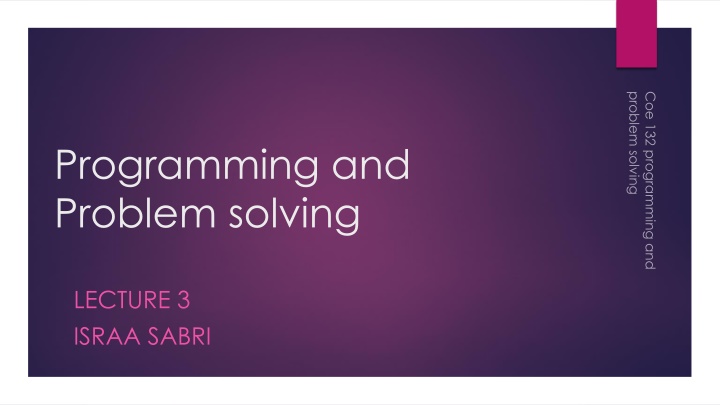
Problem Solving Algorithms and Their Characteristics
Explore the essence of problem-solving algorithms, their essential properties, and how to symbolize them using flow charts. Learn about the importance of exactness, clarity, termination, effectiveness, and generality in algorithms. Discover the implementation of strategies for efficient algorithm development.
Uploaded on | 2 Views
Download Presentation

Please find below an Image/Link to download the presentation.
The content on the website is provided AS IS for your information and personal use only. It may not be sold, licensed, or shared on other websites without obtaining consent from the author. If you encounter any issues during the download, it is possible that the publisher has removed the file from their server.
You are allowed to download the files provided on this website for personal or commercial use, subject to the condition that they are used lawfully. All files are the property of their respective owners.
The content on the website is provided AS IS for your information and personal use only. It may not be sold, licensed, or shared on other websites without obtaining consent from the author.
E N D
Presentation Transcript
Programming and Problem solving LECTURE 3 ISRAA SABRI
Problem- Solving Algorithms An algorithm is a computational procedure consisting of a set of instructions, that takes some value or set of values, as input, and produces some value or set of values, as output. Coe 132 programming and problem solving
Characteristics Of an Algorithm What makes an algorithm an algorithm? There are four essential properties of an algorithm. Each step of an algorithm must be exact. An algorithm must be exactly and clearly described. An algorithm must terminate. The purpose of an algorithm is to solve a problem. If the program does not stop when executed, we will not be able to get any result from it. Therefore, an algorithm must contain a finite number of steps in its execution. An algorithm must be effective. An algorithm must provide the correct answer to the problem. An algorithm must be general. This means that it must solve every instance of the problem. For example, a program that computes the area of a rectangle should work on all possible dimensions of the rectangle, within the limits of the programming language and the machine. Coe 132 programming and problem solving
Using Flow Chart to Symbolize Algorithm Since represented as a picture, it is called a flow chart. Let us start with an example. Suppose we have to find the sum and also the maximum of two numbers. First the two numbers have to be received and kept in two places, under two names. Then the sum of them is to be found and printed. Then depending on which one is bigger, a number is to be printed. In the flow chart, each shape has a particular meaning. the flows of computational paths are Coe 132 programming and problem solving
In the following flow chart, the first block represents the start point of the flow chart, the second block is to read the values of variables A and B. The rectangle used to calculate addition, subtracting, multiplying . Here A and B are added and the sum is saved in C. Printing process is an output, so it putted in parallelogram shape. Then the condition is placed to test if A>B. The right option of the condition is always (yes) and the left is (No). End block used to exit the flow chart. Coe 132 programming and problem solving
Implementation of strategies for algorithms Coe 132 programming and problem solving
Debugging Strategies A debugger allows the programmer, to interact and inspect the running program, making it possible to trace the flow of execution and track down the problems. For example if we forgot to put a semicolon(;) after return statement in the following programming section: 1 int main() 2 { 3 return 0 4 } Your compiler should generate an error something like \Ali.cpp(4) : error C2143: syntax error : missing ';' before '}' \main.cpp(4) The error is in the file Ali.cpp line 4 error C2143: The compiler specific error code syntax error : Messed up some syntax missing ; before } There s a missing semi-colon before a closing bracket Coe 132 programming and problem solving
Strategies to Reduce Debugging Time: The following general strategies will reduce the time that debugging takes in the process: Minimize Problems by Avoiding Copy-Paste Syndrome. Make Big Problems Found Late Small Problems Found Early Check Your Helper Functions Make sure you know what your program is doing Coe 132 programming and problem solving
Decomposition Decomposition is a technique for breaking large complex problems into a series of smaller related problems (sub-problem). There are different types of decomposition defined to solve problems: structured programming : breaks a process down into well-defined steps. Structured analysis: breaks down a software system from the system context level to system functions and data entity. Object-oriented decomposition: breaks a large system down into increasingly smaller classes or objects that are responsible for some part of the problem domain. Coe 132 programming and problem solving
The representation of decomposition concept. The first block is the main process, which contain the three blocks 1,2 and 3. Block 3 contains two other blocks 1 and 2. It is easy to programmer now to solve the problem starting with smaller problems 1 and 2 of block 3 reaching to the main block. This method is called Top-Down planning. figure above shows a general Thank you! Coe 132 programming and problem solving
